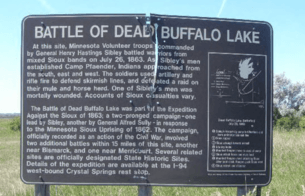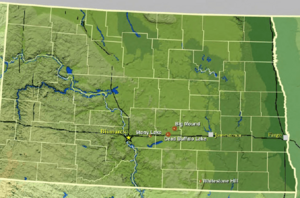Battle of Dead Buffalo Lake facts for kids
Quick facts for kids Battle of Dead Buffalo Lake |
|||||||
|---|---|---|---|---|---|---|---|
| Part of Sioux Wars, American Civil War | |||||||
 Interpretive sign at the battle site |
|||||||
|
|||||||
| Belligerents | |||||||
| United States | Teton and Santee Sioux | ||||||
| Commanders and leaders | |||||||
| Henry Hastings Sibley | Inkpaduta Sitting Bull Gall |
||||||
| Strength | |||||||
| 2,056 | 1,600 | ||||||
| Casualties and losses | |||||||
| 1 dead | 1-15 dead (estimated) | ||||||
The Battle of Dead Buffalo Lake was a small fight in July 1863. It happened in what is now North Dakota. American soldiers fought against different groups of Sioux people. The Sioux tried to take the army's supplies but did not succeed. They then left the battlefield.
Why Did the Battle of Dead Buffalo Lake Happen?
After the Dakota War of 1862, many Santee Sioux people had to leave their homes. In the summer of 1863, over 4,000 Santee and other Sioux gathered. They set up a large camp in what is now Kidder County, North Dakota.
In June and July 1863, Brigadier general Henry Hastings Sibley led a military trip. His goal was to deal with the Santee Sioux. Sibley had 2,056 soldiers. These included infantry (foot soldiers), cavalry (horse soldiers), and artillery (cannons). He also had white and Native American scouts.
On July 24, Sibley found the Sioux camp. A fight called the Battle of Big Mound began. The Sioux warriors fought to protect their families. They slowly moved back about 12 miles (20 km). The families kept fleeing towards the Missouri River for safety. The warriors stopped at Dead Buffalo Lake. This was about two miles (3 km) northwest of present-day Dawson, North Dakota. They waited there for Sibley's army to arrive.
Many Santee, led by Standing Buffalo, did not want to fight anymore. They went northwest, eventually reaching Canada. The remaining Santee, Yankton, and Yanktonai warriors stayed. Their best-known leader was Inkpaduta. About 650 Hunkpapa and Blackfoot Teton warriors joined them. This brought the total number of Native American warriors to about 1,600. Sitting Bull was one of the Teton warriors who joined the fight.
What Happened During the Battle?
Sibley's army marched to Dead Buffalo Lake on July 26. Around noon, they set up camp near the lake. Soon, mounted Sioux warriors appeared on the hills. They surrounded Sibley's camp, looking ready to attack.
Sibley moved his cannons, two groups of foot soldiers, and his pioneers forward. They went about 600 yards (550 meters) in front of his camp. They started firing at the Native Americans from a distance. The Sioux warriors moved back to a safer spot.
The Sioux's main goal seemed to be to capture the army's pack train. This was a line of horses and mules carrying supplies. If they could take the supplies, Sibley's army would be stuck. They first tried to attack Sibley's left side. But a group of mounted rangers and two groups of foot soldiers stopped them. The Native Americans then disappeared into the hills.
Some of the mule drivers in Sibley's camp thought the fighting was over. They took the animals out of the camp's defenses to let them eat grass. Suddenly, the Sioux reappeared in large numbers on the right side. They made another strong effort to capture the animals. But two groups of cavalry and six groups of foot soldiers fought them off. It was a short, close-up fight.
It is said that Sitting Bull, who only had a whip, touched a mule driver. This act, called "counting coup," was a brave deed. He then captured the mule. Since they could not capture most of the horses and mules, the Native Americans left the battlefield. The battle was over.
One soldier was killed in the battle. The soldiers believed they had killed about 15 Sioux warriors. However, armies often guessed higher numbers for Native American fighters and casualties.
What Happened After the Battle?
Sibley continued to chase the Sioux the next day. He wanted to catch them before they could cross the Missouri River. On July 28, Sibley's army fought them again at the Battle of Stony Lake.


